*"Sensing the World: Insect Sensory Systems"*
0 likes40 views
Insects' major sensory organs include compound eyes for vision, antennae for smell, taste, and touch, and ocelli for light detection, enabling navigation, food detection, and communication.
1 of 20
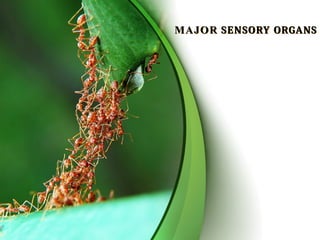

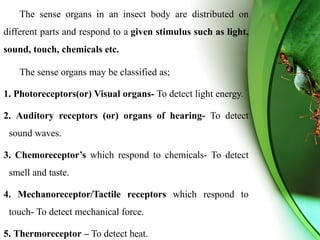


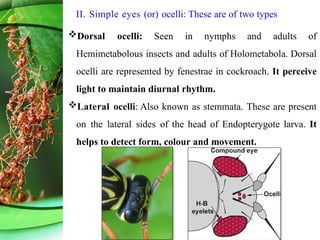
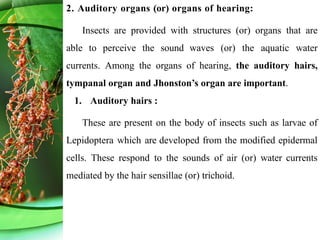






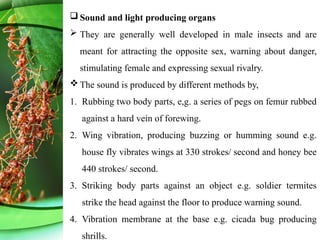






Ad
Recommended
Understanding Environmental Perception: How We Experience and Interpret Our S...



Understanding Environmental Perception: How We Experience and Interpret Our S...MonaKhimsuriya Perception of the environment refers to how individuals or groups interpret and understand their surroundings based on sensory inputs, cognitive processes, and contextual factors. This perception can vary widely among people due to differences in sensory abilities, personal experiences, cultural backgrounds, and psychological states.
Sense organs of insects and their structure



Sense organs of insects and their structureManish pal Insects have a variety of sense organs that allow them to perceive their environment. These include mechanoreceptors for touch, chemoreceptors for smell and taste, photoreceptors for vision, auditory receptors for hearing, and thermoreceptors and hygroreceptors for temperature and humidity. The main mechanoreceptors are tactile hairs, campaniform organs, and chordotonal organs. Chemoreceptors are located on antennae, mouthparts, tarsi, and other body parts. Photoreceptors include compound eyes, dorsal and lateral ocelli. Auditory receptors include tympanal organs and tactile hairs. Thermoreceptors and hygrorecept
senseorgansofinsectsandtheirstructure-180508155900.pptx



senseorgansofinsectsandtheirstructure-180508155900.pptxGopalSubash The document summarizes the different types of sense organs found in insects and their structures and functions. The main sensory organs discussed are mechanoreceptors (touch), chemoreceptors (smell and taste), photoreceptors (vision), auditory receptors (hearing), thermoreceptors (temperature), and hygroreceptors (humidity). Mechanoreceptors include tactile hairs, campaniform organs, and chordotonal organs. Chemoreceptors are located on antennae, mouthparts, tarsi and other body parts. Photoreceptors include compound eyes, dorsal and lateral ocelli. Auditory receptors can be tactile hairs or tympanal organs. Thermore
senseorgansofinsectsandtheirstructure-180508155900.pptx



senseorgansofinsectsandtheirstructure-180508155900.pptxSaiAkash44 The document summarizes the different types of sense organs found in insects that allow them to perceive stimuli in their environment. The main sensory types discussed are mechanoreceptors (touch), chemoreceptors (smell and taste), photoreceptors (vision), auditory receptors (hearing), thermoreceptors (temperature), and hygroreceptors (humidity). Each sensory type is located in different parts of the insect's body and composed of specialized cells and structures that detect stimuli and transmit sensory information to the central nervous system. Insects have evolved diverse sense organs that allow them to perceive and respond to their surroundings in similar ways as other animals through different receptors for various environmental cues.
GOPAL S 2021031026 AEN 201 ppt.pptx



GOPAL S 2021031026 AEN 201 ppt.pptxGopalSubash Insects have a variety of sense organs that allow them to perceive their environment. These include mechanoreceptors for touch, chemoreceptors for smell and taste, photoreceptors for light, auditory receptors for sound, thermoreceptors for heat, and hygroreceptors for humidity. The main sense organs are the antennae, mouthparts, legs, and in some groups, wings or tympanal organs. Insects can detect minute stimuli that allow them to find food, mates, and respond appropriately to threats and environmental changes.
Insect Sensory organs. complete ppt.Banda University of agriculture and techn...



Insect Sensory organs. complete ppt.Banda University of agriculture and techn...Banda University of Agriculture & Technology, Banda, 210001 This document discusses the different types of sense organs found in insects. It outlines five main categories of sense organs: mechanoreceptors, chemoreceptors, photoreceptors, auditory receptors, and thermoreceptors. Mechanoreceptors include tactile organs, campaniform organs, and chordotonal organs. Chemoreceptors allow insects to detect smells and tastes. Photoreceptors allow insects to sense light and include compound eyes, dorsal ocelli, and lateral eyes. Auditory receptors like tympanal membranes and organs help insects detect sounds. The document provides examples and diagrams to illustrate the different sense organs.
Olfactory and gustatory receptors



Olfactory and gustatory receptorsGovt.college,Nagda, ujjain.M.P The document discusses chemoreceptors, which include taste receptors and olfactory receptors. Taste and smell rely on chemical receptors being stimulated by certain molecules. Humans can taste sweet, sour, bitter, salty, and umami; taste and smell are directly related because they use the same types of receptors. Olfactory receptors are located in the nose, while taste receptors are located in the tongue and oral cavity. Both system detect chemicals and transmit signals to the brain.
BlessedHumanBeing.pptx



BlessedHumanBeing.pptxYellammaKuna The document compares the senses of humans and other animals. It discusses how animals like fish, frogs, snakes, and crocodiles have highly developed senses of touch, smell, taste, and hearing. It notes that while humans see ourselves as superior, many animals have senses that are more advanced than our own, such as echolocation in bats and dolphins. The document concludes that when considering the evolution and distribution of senses across the animal kingdom, we must acknowledge that in several ways animals are better equipped than humans.
Sense organs



Sense organskrishnachaitanyatiru2 The document discusses the different types of sense organs in insects, including mechanoreceptors, auditory receptors, chemoreceptors, thermoreceptors, and photoreceptors. It provides examples of each type of sense organ and their functions, such as trichoid sensilla which detect touch, Johnston's organ which detects antennal movements, and compound eyes which allow insects to detect light, form, and color. The sensory organs help insects perform important functions like finding hosts, food, and mates as well as sensing their environment.
Human sense organs



Human sense organsMusa Mathe This document discusses the five main categories of human sense organs: mechanoreceptors, chemoreceptors, electromagnetic receptors, thermoreceptors, and pain receptors. It focuses on three specific sense organs: taste buds, which are chemoreceptors that allow us to detect five basic tastes; the skin, which contains mechanoreceptors, thermoreceptors, and pain receptors that allow us to feel touch, temperature, and pain; and the eyes, which contain photoreceptors that allow us to see light and color. The document provides details on the types of sensory receptors found in each of these three sense organs and their functions in detection and perception.
Sense organs and nutritive requirements



Sense organs and nutritive requirementsMuzna Kashaf This document discusses the sensory organs and sense perception in insects. It begins by introducing the different sensory organs insects use to perceive stimuli in their environment, including sound, light, scent, gravity, and temperature. It then reviews literature on sound production and perception in insects, describing the different structures and mechanisms insects use to produce sound. Specific examples are provided for sound production in mountain crickets, cicadas, and red milkweed beetles. The document also discusses the different types of mechanoreceptors, chemoreceptors, and photoreceptors in insects and their functions in touch, taste, smell and vision. It concludes by reviewing the nutritional requirements of insects.
Ethology



Ethologyatulthakur007 Ethology is the study of animal behavior. It examines how animals respond to stimuli in their environment and focuses on behaviors related to sensory processing, communication, social interaction, learning, and motivation. Key areas of study include sign stimuli that trigger fixed action patterns, social organization, courtship displays, navigation, and kinship/social behaviors. Animals learn through instinct, imprinting, conditioning, and insight learning. Sensory filtering allows the brain to selectively process important information from the senses.
INSECT MECHANORECEPTORS: Exploring Sensory Function and Adaptive Significance.



INSECT MECHANORECEPTORS: Exploring Sensory Function and Adaptive Significance.heymen900 Insect sense organs - Mechanoreceptors
Insect sense ORGANS (MECHANO-, PHOTO- AND CHEMO- RECEPTORS): IT’S STRUCTURE, ...



Insect sense ORGANS (MECHANO-, PHOTO- AND CHEMO- RECEPTORS): IT’S STRUCTURE, ...N.m.c.a Insect sense ORGANS (MECHANO-, PHOTO- AND CHEMO- RECEPTORS): IT’S STRUCTURE, FUNCTION, AND MODIFICATION IN DIFFERENT ORDERS OF INSECT.
insect_communication_lecture_2_0.pptx



insect_communication_lecture_2_0.pptxKavimugilanS43 This document discusses insect communication. It begins by defining communication and noting that most insect communication is innate and species-specific. It then discusses the main reasons insects communicate, including recognition, mating, finding food/danger. The major ways insects communicate are visually, tactilely, acoustically, and chemically. Specific examples are given for each type, such as firefly flashing, antennation in ants/termites, cricket chirping, and moth sex pheromones. Sensory reception and specialized glands/organs used in communication are also covered.
Unit iv (sense organs)



Unit iv (sense organs)QORYANI The document summarizes the results of 5 sensory experiments:
1. A taste test identified regions of the tongue most sensitive to different tastes.
2. Pupil size changes with attention to near and far objects were measured.
3. Hearing sensitivity was measured by timing detection of clock ticks.
4. Sensitivity to hot and cold temperatures was tested by submerging hands.
5. Reaction time to pain stimulus was measured by timing removal of hand from ice.
The experiments measured sensitivity levels for different human senses like taste, sight, hearing, touch and pain. Results were recorded to understand how the senses function.
Bio 166 presentation-A



Bio 166 presentation-ACassandra Peterson The document provides an overview of the special senses of taste, hearing, smell, and vision. It includes the following key points:
- Taste is detected by taste buds on the tongue and involves four basic tastes: sweet, sour, salty, and bitter. Taste pathways transmit signals to the brainstem.
- Hearing involves the outer, middle and inner ear. Sound waves cause the eardrum and bones of the middle ear to vibrate, transmitting signals through nerves to the brain.
- Smell receptors in the nose detect odors which activate pathways to areas of the brain involved in memory and emotion.
- Vision involves light entering the eye through the cornea and lens, with
bio communication in insects



bio communication in insectsRoshan Menni This document summarizes different types of communication used by insects, including visual, chemical, tactile, and acoustic communication. It discusses how insects communicate through color patterns, pheromones, touch, dance, sounds, and vibrations to recognize others of their species, find mates, locate food, warn of danger, and more. The key forms of communication are chemical signals like pheromones that convey information between individuals of the same species, and visual signals from patterns, flashes of light, or dances that help with tasks like attracting mates or locating food sources. Insects rely on these innate communication abilities to survive and thrive in their environments.
Communication



CommunicationCindy Mayz This document provides an overview of biocommunication in insects. It discusses the main types of insect communication: visual communication using colors/patterns, chemical communication using pheromones, tactile communication through physical contact, and acoustic communication using sounds. Specific examples are given for each type, such as fireflies using light flashes, bees using dance movements to indicate food locations, and grasshoppers rubbing legs to produce sounds. The document aims to explain how insects acquire and share information through their senses of sight, smell, touch, hearing and taste.
Introductory Entomology (ENT 201)



Introductory Entomology (ENT 201)agriyouthnepal - The document provides information on the course "Introductory Entomology" including the course code, credit hours, and an introduction to the definition and study of insects.
- It defines entomology and its branches, and provides characteristics of the class Insecta including their body structure, respiratory and excretory systems.
- Reasons for the dominance of insects over other animals include their large numbers, widespread distribution, small size, flight ability, reproduction rates, and protective adaptations. Insects play both beneficial roles such as pollination and biocontrol, as well as harmful roles as agricultural pests.
Insect Sense Organs.pptx



Insect Sense Organs.pptxPrajwal Gowda M.A Insect sense organs, definition, type.
Mechanoreceptors- it's types, Auditoryreceptors- it's types,
Chemoreceptors- it's types.
Lecture 18 - Insect Sense organs - Copy.ppt



Lecture 18 - Insect Sense organs - Copy.pptDr. S.H. VIJAYALAKSHMI Insects possess five main senses: touch, hearing, smell, taste, and sight. Sensilla are hair-like sensory organs that detect stimuli from the environment and trigger responses. There are several types of sensilla that function as mechanoreceptors, auditory receptors, chemoreceptors, thermoreceptors, and photoreceptors. In particular, compound eyes composed of many ommatidia allow insects to detect light and vision, while antennae and tarsi contain chemoreceptors that detect smells and tastes. Johnston's organs and subgenual organs are examples of chordotonal organs that function as proprioceptors and detect sounds and vibrations.
Insect sense organs



Insect sense organsPrudhiviVijayBabu 1) Insects have various sensory receptors called mechanoreceptors that allow them to detect stimuli like touch, vibration, gravity and sound.
2) The main mechanoreceptors are tactile organs, campaniform sensilla, chordotonal organs, and static organs. Tactile organs are sensory hairs that detect touch and vibration. Campaniform sensilla detect forces on the cuticle from muscles or gravity. Chordotonal organs contain scolopidia that detect movement and tension. Static organs help with balance and orientation using statoliths.
3) Specialized mechanoreceptors include Johnston's organ in antennae, subgenual organs in legs, tympanal organs for hearing
Vertebrates characteristics by Manuela 5ºA



Vertebrates characteristics by Manuela 5ºAoscargrcgrc Vertebrates are animals with an internal skeleton that allows movement. They have a spinal column, head, trunk, and limbs. The five main groups are mammals, birds, fish, amphibians, and reptiles. Mammals have a well-developed sense of touch and smell that helps many find mates or locate food. Their ears are complex with outer, middle, and inner structures that transmit sound vibrations to the brain. Most mammals reproduce viviparously by giving live birth, unlike other vertebrates that often lay eggs.
Receptor organs in vertebrates



Receptor organs in vertebratessunandakumre Sense organs are the specialized organs composed of sensory neurons, which help us to perceive and respond to our surroundings. There are five sense organs – eyes, ears, nose, tongue, and skin.
External receptors (exteroceptors): sense organs for touch, smell, taste, sight and hearing.
Internal receptors (interocepyors): these sense organs found in the body which detect the temperature, pain, hunger, thirst, fatigue and muscle position.
Animal Senses



Animal Sensesvacagodx The document discusses several animal senses that differ from human senses, including echolocation, electroreception, chemoreception, vision beyond the visible light spectrum, infrared vision, magnetoreception, and head tracking in chickens. Echolocating animals like bats use echo ___location to navigate and hunt by emitting calls and interpreting the returning echoes. Electroreception allows some aquatic animals to detect electric fields for navigation and hunting prey. Various animals have enhanced chemoreception, vision, infrared detection and magnetoreception abilities compared to humans.
Communication In insects



Communication In insectsAmmad Ahmad This presentation discusses communication in insects. It introduces the topic and defines communication as the exchange of information between individuals. Most insect communication is innate and inherited. The presentation then explores why insects communicate, including for recognition, mating, finding food or danger, and establishing territories. It identifies the main types of insect communication as visual, chemical, tactile, and sound. Specific examples are provided, such as the use of pheromones, dances, touching, and sounds produced by wings, legs or other body parts.
*"The Wonderful World of Insect Wings"* pptx.



*"The Wonderful World of Insect Wings"* pptx.Arshad Shaikh Insect wings are modified appendages that enable flight. They are composed of thin membranes supported by veins. Modifications include variations in shape, size, and venation. There are two main types of wings: hindwings and forewings, which can be similar (as in dragonflies) or different (as in beetles). Some insects have coupling apparatuses, such as hamuli (small hooks) in Hymenoptera (bees, wasps, ants) or jugum in some moths, that link the hindwings and forewings together during flight, enhancing aerodynamic efficiency and maneuverability. These modifications contribute to the incredible diversity of insect flight capabilities.
Insect Legs: Specialized for Success"* pptx.



Insect Legs: Specialized for Success"* pptx.Arshad Shaikh Insect legs are jointed appendages used for walking, running, jumping, and other functions. They typically consist of six segments: coxa, trochanter, femur, tibia, tarsus, and pretarsus. There are various types of insect legs, including:
- Cursorial legs (for running)
- Saltatorial legs (for jumping)
- Fossorial legs (for digging)
- Natatorial legs (for swimming)
- Raptorial legs (for grasping prey)
Each type is adapted for specific functions and environments, showcasing the remarkable diversity of insect legs.
Ad
More Related Content
Similar to *"Sensing the World: Insect Sensory Systems"* (20)
BlessedHumanBeing.pptx



BlessedHumanBeing.pptxYellammaKuna The document compares the senses of humans and other animals. It discusses how animals like fish, frogs, snakes, and crocodiles have highly developed senses of touch, smell, taste, and hearing. It notes that while humans see ourselves as superior, many animals have senses that are more advanced than our own, such as echolocation in bats and dolphins. The document concludes that when considering the evolution and distribution of senses across the animal kingdom, we must acknowledge that in several ways animals are better equipped than humans.
Sense organs



Sense organskrishnachaitanyatiru2 The document discusses the different types of sense organs in insects, including mechanoreceptors, auditory receptors, chemoreceptors, thermoreceptors, and photoreceptors. It provides examples of each type of sense organ and their functions, such as trichoid sensilla which detect touch, Johnston's organ which detects antennal movements, and compound eyes which allow insects to detect light, form, and color. The sensory organs help insects perform important functions like finding hosts, food, and mates as well as sensing their environment.
Human sense organs



Human sense organsMusa Mathe This document discusses the five main categories of human sense organs: mechanoreceptors, chemoreceptors, electromagnetic receptors, thermoreceptors, and pain receptors. It focuses on three specific sense organs: taste buds, which are chemoreceptors that allow us to detect five basic tastes; the skin, which contains mechanoreceptors, thermoreceptors, and pain receptors that allow us to feel touch, temperature, and pain; and the eyes, which contain photoreceptors that allow us to see light and color. The document provides details on the types of sensory receptors found in each of these three sense organs and their functions in detection and perception.
Sense organs and nutritive requirements



Sense organs and nutritive requirementsMuzna Kashaf This document discusses the sensory organs and sense perception in insects. It begins by introducing the different sensory organs insects use to perceive stimuli in their environment, including sound, light, scent, gravity, and temperature. It then reviews literature on sound production and perception in insects, describing the different structures and mechanisms insects use to produce sound. Specific examples are provided for sound production in mountain crickets, cicadas, and red milkweed beetles. The document also discusses the different types of mechanoreceptors, chemoreceptors, and photoreceptors in insects and their functions in touch, taste, smell and vision. It concludes by reviewing the nutritional requirements of insects.
Ethology



Ethologyatulthakur007 Ethology is the study of animal behavior. It examines how animals respond to stimuli in their environment and focuses on behaviors related to sensory processing, communication, social interaction, learning, and motivation. Key areas of study include sign stimuli that trigger fixed action patterns, social organization, courtship displays, navigation, and kinship/social behaviors. Animals learn through instinct, imprinting, conditioning, and insight learning. Sensory filtering allows the brain to selectively process important information from the senses.
INSECT MECHANORECEPTORS: Exploring Sensory Function and Adaptive Significance.



INSECT MECHANORECEPTORS: Exploring Sensory Function and Adaptive Significance.heymen900 Insect sense organs - Mechanoreceptors
Insect sense ORGANS (MECHANO-, PHOTO- AND CHEMO- RECEPTORS): IT’S STRUCTURE, ...



Insect sense ORGANS (MECHANO-, PHOTO- AND CHEMO- RECEPTORS): IT’S STRUCTURE, ...N.m.c.a Insect sense ORGANS (MECHANO-, PHOTO- AND CHEMO- RECEPTORS): IT’S STRUCTURE, FUNCTION, AND MODIFICATION IN DIFFERENT ORDERS OF INSECT.
insect_communication_lecture_2_0.pptx



insect_communication_lecture_2_0.pptxKavimugilanS43 This document discusses insect communication. It begins by defining communication and noting that most insect communication is innate and species-specific. It then discusses the main reasons insects communicate, including recognition, mating, finding food/danger. The major ways insects communicate are visually, tactilely, acoustically, and chemically. Specific examples are given for each type, such as firefly flashing, antennation in ants/termites, cricket chirping, and moth sex pheromones. Sensory reception and specialized glands/organs used in communication are also covered.
Unit iv (sense organs)



Unit iv (sense organs)QORYANI The document summarizes the results of 5 sensory experiments:
1. A taste test identified regions of the tongue most sensitive to different tastes.
2. Pupil size changes with attention to near and far objects were measured.
3. Hearing sensitivity was measured by timing detection of clock ticks.
4. Sensitivity to hot and cold temperatures was tested by submerging hands.
5. Reaction time to pain stimulus was measured by timing removal of hand from ice.
The experiments measured sensitivity levels for different human senses like taste, sight, hearing, touch and pain. Results were recorded to understand how the senses function.
Bio 166 presentation-A



Bio 166 presentation-ACassandra Peterson The document provides an overview of the special senses of taste, hearing, smell, and vision. It includes the following key points:
- Taste is detected by taste buds on the tongue and involves four basic tastes: sweet, sour, salty, and bitter. Taste pathways transmit signals to the brainstem.
- Hearing involves the outer, middle and inner ear. Sound waves cause the eardrum and bones of the middle ear to vibrate, transmitting signals through nerves to the brain.
- Smell receptors in the nose detect odors which activate pathways to areas of the brain involved in memory and emotion.
- Vision involves light entering the eye through the cornea and lens, with
bio communication in insects



bio communication in insectsRoshan Menni This document summarizes different types of communication used by insects, including visual, chemical, tactile, and acoustic communication. It discusses how insects communicate through color patterns, pheromones, touch, dance, sounds, and vibrations to recognize others of their species, find mates, locate food, warn of danger, and more. The key forms of communication are chemical signals like pheromones that convey information between individuals of the same species, and visual signals from patterns, flashes of light, or dances that help with tasks like attracting mates or locating food sources. Insects rely on these innate communication abilities to survive and thrive in their environments.
Communication



CommunicationCindy Mayz This document provides an overview of biocommunication in insects. It discusses the main types of insect communication: visual communication using colors/patterns, chemical communication using pheromones, tactile communication through physical contact, and acoustic communication using sounds. Specific examples are given for each type, such as fireflies using light flashes, bees using dance movements to indicate food locations, and grasshoppers rubbing legs to produce sounds. The document aims to explain how insects acquire and share information through their senses of sight, smell, touch, hearing and taste.
Introductory Entomology (ENT 201)



Introductory Entomology (ENT 201)agriyouthnepal - The document provides information on the course "Introductory Entomology" including the course code, credit hours, and an introduction to the definition and study of insects.
- It defines entomology and its branches, and provides characteristics of the class Insecta including their body structure, respiratory and excretory systems.
- Reasons for the dominance of insects over other animals include their large numbers, widespread distribution, small size, flight ability, reproduction rates, and protective adaptations. Insects play both beneficial roles such as pollination and biocontrol, as well as harmful roles as agricultural pests.
Insect Sense Organs.pptx



Insect Sense Organs.pptxPrajwal Gowda M.A Insect sense organs, definition, type.
Mechanoreceptors- it's types, Auditoryreceptors- it's types,
Chemoreceptors- it's types.
Lecture 18 - Insect Sense organs - Copy.ppt



Lecture 18 - Insect Sense organs - Copy.pptDr. S.H. VIJAYALAKSHMI Insects possess five main senses: touch, hearing, smell, taste, and sight. Sensilla are hair-like sensory organs that detect stimuli from the environment and trigger responses. There are several types of sensilla that function as mechanoreceptors, auditory receptors, chemoreceptors, thermoreceptors, and photoreceptors. In particular, compound eyes composed of many ommatidia allow insects to detect light and vision, while antennae and tarsi contain chemoreceptors that detect smells and tastes. Johnston's organs and subgenual organs are examples of chordotonal organs that function as proprioceptors and detect sounds and vibrations.
Insect sense organs



Insect sense organsPrudhiviVijayBabu 1) Insects have various sensory receptors called mechanoreceptors that allow them to detect stimuli like touch, vibration, gravity and sound.
2) The main mechanoreceptors are tactile organs, campaniform sensilla, chordotonal organs, and static organs. Tactile organs are sensory hairs that detect touch and vibration. Campaniform sensilla detect forces on the cuticle from muscles or gravity. Chordotonal organs contain scolopidia that detect movement and tension. Static organs help with balance and orientation using statoliths.
3) Specialized mechanoreceptors include Johnston's organ in antennae, subgenual organs in legs, tympanal organs for hearing
Vertebrates characteristics by Manuela 5ºA



Vertebrates characteristics by Manuela 5ºAoscargrcgrc Vertebrates are animals with an internal skeleton that allows movement. They have a spinal column, head, trunk, and limbs. The five main groups are mammals, birds, fish, amphibians, and reptiles. Mammals have a well-developed sense of touch and smell that helps many find mates or locate food. Their ears are complex with outer, middle, and inner structures that transmit sound vibrations to the brain. Most mammals reproduce viviparously by giving live birth, unlike other vertebrates that often lay eggs.
Receptor organs in vertebrates



Receptor organs in vertebratessunandakumre Sense organs are the specialized organs composed of sensory neurons, which help us to perceive and respond to our surroundings. There are five sense organs – eyes, ears, nose, tongue, and skin.
External receptors (exteroceptors): sense organs for touch, smell, taste, sight and hearing.
Internal receptors (interocepyors): these sense organs found in the body which detect the temperature, pain, hunger, thirst, fatigue and muscle position.
Animal Senses



Animal Sensesvacagodx The document discusses several animal senses that differ from human senses, including echolocation, electroreception, chemoreception, vision beyond the visible light spectrum, infrared vision, magnetoreception, and head tracking in chickens. Echolocating animals like bats use echo ___location to navigate and hunt by emitting calls and interpreting the returning echoes. Electroreception allows some aquatic animals to detect electric fields for navigation and hunting prey. Various animals have enhanced chemoreception, vision, infrared detection and magnetoreception abilities compared to humans.
Communication In insects



Communication In insectsAmmad Ahmad This presentation discusses communication in insects. It introduces the topic and defines communication as the exchange of information between individuals. Most insect communication is innate and inherited. The presentation then explores why insects communicate, including for recognition, mating, finding food or danger, and establishing territories. It identifies the main types of insect communication as visual, chemical, tactile, and sound. Specific examples are provided, such as the use of pheromones, dances, touching, and sounds produced by wings, legs or other body parts.
More from Arshad Shaikh (12)
*"The Wonderful World of Insect Wings"* pptx.



*"The Wonderful World of Insect Wings"* pptx.Arshad Shaikh Insect wings are modified appendages that enable flight. They are composed of thin membranes supported by veins. Modifications include variations in shape, size, and venation. There are two main types of wings: hindwings and forewings, which can be similar (as in dragonflies) or different (as in beetles). Some insects have coupling apparatuses, such as hamuli (small hooks) in Hymenoptera (bees, wasps, ants) or jugum in some moths, that link the hindwings and forewings together during flight, enhancing aerodynamic efficiency and maneuverability. These modifications contribute to the incredible diversity of insect flight capabilities.
Insect Legs: Specialized for Success"* pptx.



Insect Legs: Specialized for Success"* pptx.Arshad Shaikh Insect legs are jointed appendages used for walking, running, jumping, and other functions. They typically consist of six segments: coxa, trochanter, femur, tibia, tarsus, and pretarsus. There are various types of insect legs, including:
- Cursorial legs (for running)
- Saltatorial legs (for jumping)
- Fossorial legs (for digging)
- Natatorial legs (for swimming)
- Raptorial legs (for grasping prey)
Each type is adapted for specific functions and environments, showcasing the remarkable diversity of insect legs.
*"Insect Mouthparts: Adaptations for Feeding"*pptx



*"Insect Mouthparts: Adaptations for Feeding"*pptxArshad Shaikh Insect mouthparts are highly adaptable structures used for feeding, consisting of several key components, including the mandibles (jaws), maxillae, and labium. These parts work together to manipulate and process food. There are several types of mouthparts, including:
1. *Chewing mouthparts*: Found in insects like beetles and grasshoppers, these mouthparts are used for grinding and crushing solid food.
2. *Siphoning mouthparts*: Butterflies and moths have siphoning mouthparts, which are long, tube-like structures used for sucking nectar from flowers.
3. *Piercing-sucking mouthparts*: Insects like mosquitoes and aphids have piercing-sucking mouthparts, which are used to penetrate plant or animal tissue and suck out fluids.
4. *Sponging mouthparts*: Houseflies have sponging mouthparts, which are used to soak up liquids and soft foods.
This diversity of mouthparts allows insects to exploit a wide range of food sources, from solid plant material to nectar, blood, and more.
*"The Multifunctional Marvels of Insect Antennae"*.pptx



*"The Multifunctional Marvels of Insect Antennae"*.pptxArshad Shaikh Insect antennae are highly specialized sensory organs composed of multiple segments, typically consisting of a basal segment (scape), a pedicel, and a flagellum. These segments contain sensory receptors that detect various stimuli, such as odors, sounds, and vibrations. Antennae are usually located on the insect's head and play a crucial role in navigation, mate selection, food detection, and predator avoidance, allowing insects to interact with their environment and respond to changes.
*"The Segmented Blueprint: Unlocking Insect Body Architecture"*.pptx



*"The Segmented Blueprint: Unlocking Insect Body Architecture"*.pptxArshad Shaikh Insects have a segmented body plan, typically divided into three main parts: the head, thorax, and abdomen. The head contains sensory organs and mouthparts, the thorax bears wings and legs, and the abdomen houses digestive and reproductive organs. This segmentation allows for specialized functions and efficient body organization.
Lecture 4 INSECT CUTICLE and moulting.pptx



Lecture 4 INSECT CUTICLE and moulting.pptxArshad Shaikh The insect cuticle is a tough, external exoskeleton composed of chitin and proteins, providing protection and support. However, as insects grow, they need to shed this cuticle periodically through a process called moulting. During moulting, a new cuticle is prepared underneath, and the old one is shed, allowing the insect to grow, repair damaged cuticle, and change form. This process is crucial for insect development and growth, enabling them to transition from one stage to another, such as from larva to pupa or adult.
Lecture 3*"The Dominance of Insects"* .pptx



Lecture 3*"The Dominance of Insects"* .pptxArshad Shaikh Insects dominate Earth's ecosystems due to their adaptability, diversity, and reproductive success, making them one of the most successful groups of organisms.
Lecture 2 CLASSIFICATION OF PHYLUM ARTHROPODA UPTO CLASSES & POSITION OF_1.pptx



Lecture 2 CLASSIFICATION OF PHYLUM ARTHROPODA UPTO CLASSES & POSITION OF_1.pptxArshad Shaikh *Phylum Arthropoda* includes animals with jointed appendages, segmented bodies, and exoskeletons. It's divided into subphyla like Chelicerata (spiders), Crustacea (crabs), Hexapoda (insects), and Myriapoda (millipedes, centipedes). This phylum is one of the most diverse groups of animals.
Lecture 1 Introduction history and institutes of entomology_1.pptx



Lecture 1 Introduction history and institutes of entomology_1.pptxArshad Shaikh *Entomology* is the scientific study of insects, including their behavior, ecology, evolution, classification, and management.
Entomology continues to evolve, incorporating new technologies and approaches to understand and manage insect populations.
Metamorphosis: Life's Transformative Journey



Metamorphosis: Life's Transformative JourneyArshad Shaikh *Metamorphosis* is a biological process where an animal undergoes a dramatic transformation from a juvenile or larval stage to a adult stage, often involving significant changes in form and structure. This process is commonly seen in insects, amphibians, and some other animals.
To study the nervous system of insect.pptx



To study the nervous system of insect.pptxArshad Shaikh The *nervous system of insects* is a complex network of nerve cells (neurons) and supporting cells that process and transmit information. Here's an overview:
Structure
1. *Brain*: The insect brain is a complex structure that processes sensory information, controls behavior, and integrates information.
2. *Ventral nerve cord*: A chain of ganglia (nerve clusters) that runs along the insect's body, controlling movement and sensory processing.
3. *Peripheral nervous system*: Nerves that connect the central nervous system to sensory organs and muscles.
Functions
1. *Sensory processing*: Insects can detect and respond to various stimuli, such as light, sound, touch, taste, and smell.
2. *Motor control*: The nervous system controls movement, including walking, flying, and feeding.
3. *Behavioral responThe *nervous system of insects* is a complex network of nerve cells (neurons) and supporting cells that process and transmit information. Here's an overview:
Structure
1. *Brain*: The insect brain is a complex structure that processes sensory information, controls behavior, and integrates information.
2. *Ventral nerve cord*: A chain of ganglia (nerve clusters) that runs along the insect's body, controlling movement and sensory processing.
3. *Peripheral nervous system*: Nerves that connect the central nervous system to sensory organs and muscles.
Functions
1. *Sensory processing*: Insects can detect and respond to various stimuli, such as light, sound, touch, taste, and smell.
2. *Motor control*: The nervous system controls movement, including walking, flying, and feeding.
3. *Behavioral responses*: Insects can exhibit complex behaviors, such as mating, foraging, and social interactions.
Characteristics
1. *Decentralized*: Insect nervous systems have some autonomy in different body parts.
2. *Specialized*: Different parts of the nervous system are specialized for specific functions.
3. *Efficient*: Insect nervous systems are highly efficient, allowing for rapid processing and response to stimuli.
The insect nervous system is a remarkable example of evolutionary adaptation, enabling insects to thrive in diverse environments.
The insect nervous system is a remarkable example of evolutionary adaptation, enabling insects to thrive
To study Digestive system of insect.pptx



To study Digestive system of insect.pptxArshad Shaikh Education is one thing no one can take away from you.”
Ad
Recently uploaded (20)
antiquity of writing in ancient India- literary & archaeological evidence



antiquity of writing in ancient India- literary & archaeological evidencePrachiSontakke5 for the students of BA Sem
BÀI TẬP BỔ TRỢ TIẾNG ANH 9 THEO ĐƠN VỊ BÀI HỌC - GLOBAL SUCCESS - CẢ NĂM (TỪ...



BÀI TẬP BỔ TRỢ TIẾNG ANH 9 THEO ĐƠN VỊ BÀI HỌC - GLOBAL SUCCESS - CẢ NĂM (TỪ...Nguyen Thanh Tu Collection https://app.box.com/s/yfwqwcillls0z4p34958pr8nj0b4udyr
Ancient Stone Sculptures of India: As a Source of Indian History



Ancient Stone Sculptures of India: As a Source of Indian HistoryVirag Sontakke This Presentation is prepared for Graduate Students. A presentation that provides basic information about the topic. Students should seek further information from the recommended books and articles. This presentation is only for students and purely for academic purposes. I took/copied the pictures/maps included in the presentation are from the internet. The presenter is thankful to them and herewith courtesy is given to all. This presentation is only for academic purposes.
Chemotherapy of Malignancy -Anticancer.pptx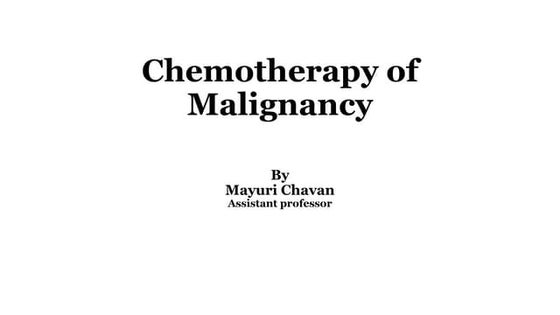



Chemotherapy of Malignancy -Anticancer.pptxMayuri Chavan Chemotherapy of Malignancy -Anticancer.pptx
APGAR SCORE BY sweety Tamanna Mahapatra MSc Pediatric



APGAR SCORE BY sweety Tamanna Mahapatra MSc PediatricSweetytamannaMohapat Learn about the APGAR SCORE , a simple yet effective method to evaluate a newborn's physical condition immediately after birth ....this presentation covers .....
what is apgar score ?
Components of apgar score.
Scoring system
Indications of apgar score........
How to Manage Amounts in Local Currency in Odoo 18 Purchase



How to Manage Amounts in Local Currency in Odoo 18 PurchaseCeline George In this slide, we’ll discuss on how to manage amounts in local currency in Odoo 18 Purchase. Odoo 18 allows us to manage purchase orders and invoices in our local currency.
Myopathies (muscle disorders) for undergraduate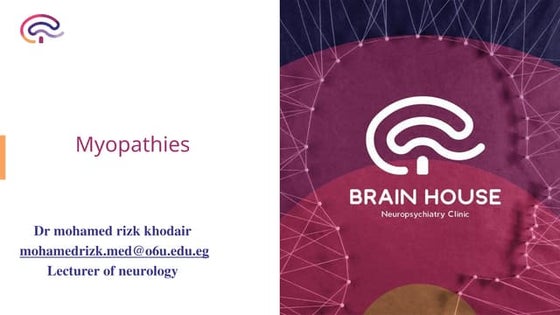



Myopathies (muscle disorders) for undergraduateMohamed Rizk Khodair herediatary myopthies
myotonia
inflammatory myopthies
Form View Attributes in Odoo 18 - Odoo Slides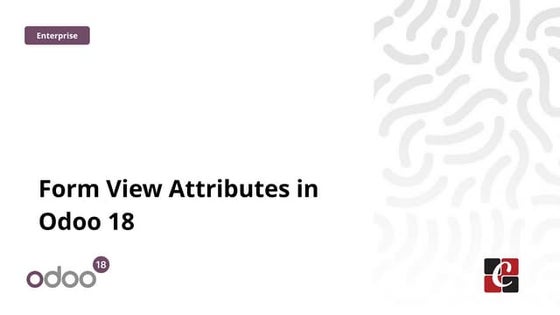



Form View Attributes in Odoo 18 - Odoo SlidesCeline George Odoo is a versatile and powerful open-source business management software, allows users to customize their interfaces for an enhanced user experience. A key element of this customization is the utilization of Form View attributes.
PHYSIOLOGY MCQS By DR. NASIR MUSTAFA (PHYSIOLOGY)



PHYSIOLOGY MCQS By DR. NASIR MUSTAFA (PHYSIOLOGY)Dr. Nasir Mustafa PHYSIOLOGY MCQS By DR. NASIR MUSTAFA (PHYSIOLOGY)
spinal cord disorders (Myelopathies and radiculoapthies)



spinal cord disorders (Myelopathies and radiculoapthies)Mohamed Rizk Khodair Myelopathies
Radiculopathies
Botany Assignment Help Guide - Academic Excellence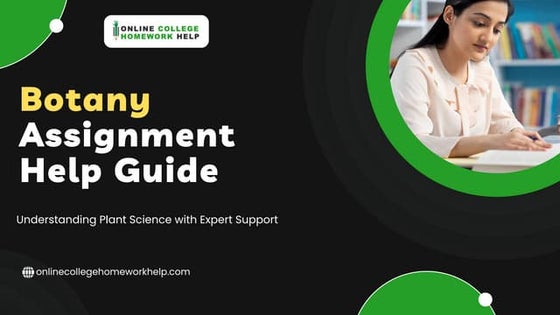



Botany Assignment Help Guide - Academic Excellenceonline college homework help Struggling with your botany assignments? This comprehensive guide is designed to support college students in mastering key concepts of plant biology. Whether you're dealing with plant anatomy, physiology, ecology, or taxonomy, this guide offers helpful explanations, study tips, and insights into how assignment help services can make learning more effective and stress-free.
📌What's Inside:
• Introduction to Botany
• Core Topics covered
• Common Student Challenges
• Tips for Excelling in Botany Assignments
• Benefits of Tutoring and Academic Support
• Conclusion and Next Steps
Perfect for biology students looking for academic support, this guide is a useful resource for improving grades and building a strong understanding of botany.
WhatsApp:- +91-9878492406
Email:- [email protected]
Website:- https://onlinecollegehomeworkhelp.com/botany-homework-help
Ajanta Paintings: Study as a Source of History



Ajanta Paintings: Study as a Source of HistoryVirag Sontakke This Presentation is prepared for Graduate Students. A presentation that provides basic information about the topic. Students should seek further information from the recommended books and articles. This presentation is only for students and purely for academic purposes. I took/copied the pictures/maps included in the presentation are from the internet. The presenter is thankful to them and herewith courtesy is given to all. This presentation is only for academic purposes.
Rock Art As a Source of Ancient Indian History



Rock Art As a Source of Ancient Indian HistoryVirag Sontakke This Presentation is prepared for Graduate Students. A presentation that provides basic information about the topic. Students should seek further information from the recommended books and articles. This presentation is only for students and purely for academic purposes. I took/copied the pictures/maps included in the presentation are from the internet. The presenter is thankful to them and herewith courtesy is given to all. This presentation is only for academic purposes.
Overview Well-Being and Creative Careers



Overview Well-Being and Creative CareersUniversity of Amsterdam Slides to support presentations and the publication of my book Well-Being and Creative Careers: What Makes You Happy Can Also Make You Sick, out in September 2025 with Intellect Books in the UK and worldwide, distributed in the US by The University of Chicago Press.
In this book and presentation, I investigate the systemic issues that make creative work both exhilarating and unsustainable. Drawing on extensive research and in-depth interviews with media professionals, the hidden downsides of doing what you love get documented, analyzing how workplace structures, high workloads, and perceived injustices contribute to mental and physical distress.
All of this is not just about what’s broken; it’s about what can be done. The talk concludes with providing a roadmap for rethinking the culture of creative industries and offers strategies for balancing passion with sustainability.
With this book and presentation I hope to challenge us to imagine a healthier future for the labor of love that a creative career is.
Cultivation Practice of Turmeric in Nepal.pptx



Cultivation Practice of Turmeric in Nepal.pptxUmeshTimilsina1 Cultivation Practice of Turmeric in Nepal
The History of Kashmir Karkota Dynasty NEP.pptx



The History of Kashmir Karkota Dynasty NEP.pptxArya Mahila P. G. College, Banaras Hindu University, Varanasi, India. This slide is an exercise for the inquisitive students preparing for the competitive examinations of the undergraduate and postgraduate students. An attempt is being made to present the slide keeping in mind the New Education Policy (NEP). An attempt has been made to give the references of the facts at the end of the slide. If new facts are discovered in the near future, this slide will be revised.
This presentation is related to the brief History of Kashmir (Part-I) with special reference to Karkota Dynasty. In the seventh century a person named Durlabhvardhan founded the Karkot dynasty in Kashmir. He was a functionary of Baladitya, the last king of the Gonanda dynasty. This dynasty ruled Kashmir before the Karkot dynasty. He was a powerful king. Huansang tells us that in his time Taxila, Singhpur, Ursha, Punch and Rajputana were parts of the Kashmir state.
BÀI TẬP BỔ TRỢ TIẾNG ANH 9 THEO ĐƠN VỊ BÀI HỌC - GLOBAL SUCCESS - CẢ NĂM (TỪ...



BÀI TẬP BỔ TRỢ TIẾNG ANH 9 THEO ĐƠN VỊ BÀI HỌC - GLOBAL SUCCESS - CẢ NĂM (TỪ...Nguyen Thanh Tu Collection
The History of Kashmir Karkota Dynasty NEP.pptx



The History of Kashmir Karkota Dynasty NEP.pptxArya Mahila P. G. College, Banaras Hindu University, Varanasi, India.
Ad
*"Sensing the World: Insect Sensory Systems"*
- 2. Agricultural Entomology (Sixth Deans’ Committee Recommended Syllabus) Course No: ENTO: 121 Course Title: Fundamentals of Entomology By, Mr. Arshad K. Shaikh Assistant Professor Institute: Sharadchandraji Pawar Institute of Agricultural Sciences, Kharavate- Dahiwali, Tal. Chiplun, Dist. Ratnagiri. Dr. Balasaheb Sawant Konkan Krishi Vidyapeeth, Dapoli [email protected]
- 3. The sense organs in an insect body are distributed on different parts and respond to a given stimulus such as light, sound, touch, chemicals etc. The sense organs may be classified as; 1. Photoreceptors(or) Visual organs- To detect light energy. 2. Auditory receptors (or) organs of hearing- To detect sound waves. 3. Chemoreceptor’s which respond to chemicals- To detect smell and taste. 4. Mechanoreceptor/Tactile receptors which respond to touch- To detect mechanical force. 5. Thermoreceptor – To detect heat.
- 4. 1.Visual organs or photoreceptors: These are two types, Compound eyes and Simple eyes. I. Compound eyes: These organs possess the ability to perceive light energy and able to produce a nerve impulse. The compound eyes may be completely absent in insects like Protura or they may remain reduced in endoparasitic Hymenoptera. The compound eyes are present on either side of the head capsule of an adult insect and also in the nymphs of Exopterygota. These are a pair and consist of number of individual units (or) facets called ommatidia. Function is to gather light.
- 5. Classification of Compound eyes based on image formation; Apposition eyes: These are active during day time (diurnal insects);e.g.: butterflies. Superposition eyes: These are active during evening and night time (Nocturnal insects); e.g.: moths. Apposition eyes Superposition eyes
- 6. II. Simple eyes (or) ocelli: These are of two types Dorsal ocelli: Seen in nymphs and adults of Hemimetabolous insects and adults of Holometabola. Dorsal ocelli are represented by fenestrae in cockroach. It perceive light to maintain diurnal rhythm. Lateral ocelli: Also known as stemmata. These are present on the lateral sides of the head of Endopterygote larva. It helps to detect form, colour and movement.
- 7. 2. Auditory organs (or) organs of hearing: Insects are provided with structures (or) organs that are able to perceive the sound waves (or) the aquatic water currents. Among the organs of hearing, the auditory hairs, tympanal organ and Jhonston’s organ are important. 1. Auditory hairs : These are present on the body of insects such as larvae of Lepidoptera which are developed from the modified epidermal cells. These respond to the sounds of air (or) water currents mediated by the hair sensillae (or) trichoid.
- 8. 2. Tympanal organ : Tympanum is present one on either side of the 1st abdominal segment of short horned grasshoppers, on the base of foretibia in long horned grasshoppers and crickets, and on thorax or abdomen in Lepidoptera. 3. Jhonston’s organ: It is present on the pedicel of antennae and functions as an auditory organ responding to air (or) water currents. They are absent in Collembola. 4. Pilifer of hawk moths (Sphingid moths): A unique auditory organ, sensitive to ultrasonic frequencies is found in the head of several species of
- 10. 3. Mechanoreceptor: (Detect mechanical force) Trichoid sensilla: Hair like sense organ. Sense cell associated with spur and seta. These cells are sensitive to touch and are located in antenna and mouthparts. Campaniform / Dome sensilla: These cells are sensitive to pressure and located in legs joints and wing bases. Chordotonal organ: The specialized sensory organs that receive vibration are subcuticular mechanoreceptors called chordotonal organ.
- 13. 3. Chemoreceptors: (detect smell and taste): It contains sensilla with one pore (uniporous) or more pores (multiporous). ♣ Uniporous chemoreceptors mostly detect chemicals of solid and liquid form by contact called gustatory receptors and located in antennae. ♣ Multiporous chemoreceptor’s detect chemicals in vapour form at distant by smell called olfactory receptors and located in mouth and tarsi. 5.Thermoreceptor – (detect heat) Present in poikilothermic insects and sensitive to temperature changes. E.g. Bed bugs.
- 14. Sound and light producing organs They are generally well developed in male insects and are meant for attracting the opposite sex, warning about danger, stimulating female and expressing sexual rivalry. The sound is produced by different methods by, 1. Rubbing two body parts, e,g. a series of pegs on femur rubbed against a hard vein of forewing. 2. Wing vibration, producing buzzing or humming sound e.g. house fly vibrates wings at 330 strokes/ second and honey bee 440 strokes/ second. 3. Striking body parts against an object e.g. soldier termites strike the head against the floor to produce warning sound. 4. Vibration membrane at the base e.g. cicada bug producing shrills.
- 17. Light producing organs Such are popularly known as fire flies, glow worms, or blinkers. They may be self luminous due to photogenic organs or may contain photogenic bacteria or the food consumed by them may be luminous. The light produced may be continuous, intermittent or pulsating. It helps in attracting the sexes for mating. The light is emitted when luciferin is oxydised by free oxygen in presence of water and an enzyme luciferace producing oxyluciferin.




